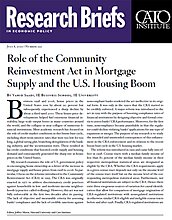My research examines the role of U.S. government policy in encouraging home ownership as a driver of the increase in mortgage supply and house prices from 1998 to 2006. In particular, I focus on the reforms introduced to the Community Reinvestment Act (CRA) in 1995. The CRA was originally enacted in 1977 to address discriminatory credit practices against households in low- and moderate-income neighborhoods (a practice called redlining). However, this act was not fully enforceable in the first two decades after its passing. The lack of objective and measurable criteria for assessing banks’ compliance and the lack of credible sanctions against noncompliant banks rendered the act ineffective in its original form. It was only in the 1990s that the CRA started to be credibly enforced. A major reform was introduced to the act in 1995 with the purpose of boosting compliance rates of financial institutions by designing objective and formal criteria to assess banks’ CRA performance. Moreover, for the first time, noncompliance became punishable in that the regulator could decline violating banks’ applications for any type of expansion or merger. The purpose of my research is to study the intended and unintended consequences of this enhancement in the CRA enforcement and its relation to the recent boom-bust cycle in the U.S. housing market.
The reform was introduced in 1995 and came fully into effect in 1998. Census tracts with a median family income of less than 80 percent of the median family income in their respective metropolitan statistical areas are designated as eligible by the CRA. Whether the CRA requirements apply in a given census tract depends not only on the income level of the census tract itself but on the income level of the corresponding metropolitan statistical areas. Furthermore, not all financial institutions are subject to the CRA. Hence there exist three exogenous sources of variation for causal identification that allow for comparison of mortgage origination of CRA-regulated institutions with nonregulated institutions in otherwise similar CRA-eligible and ineligible census tracts before and after 1998. Finally, CRA-regulated institutions are examined for compliance with the CRA only inside their assessment areas, allowing for further tests to ensure the robustness of the results.
My analysis provides evidence of tougher enforcement of the CRA in the mid-1990s, consistent with the objective of the reform. Starting in 1995, the share of banks with an outstanding rating, which is the best rating under the CRA, declines sharply. CRA-regulated banks, unlike other financial institutions, increased their mortgage origination to CRA-eligible census tracts across the income distribution. CRA-eligible census tracts experienced a higher house-price growth during the boom because of the shift in mortgage supply by CRA-regulated banks. The collapse of house prices from 2007 to 2009 was more severe in CRA-eligible census tracts. Finally, I find that CRA-induced mortgages were slightly riskier ex ante but experienced considerably more frequent delinquencies ex post.
I document the unintended consequences of a well-intended policy meant to increase homeownership in less-advantaged neighborhoods. Shift in the supply of mortgages resulted in an increase in house prices, which made housing less affordable, contrary to the objectives of the act. By intensifying the boom-bust cycle, it also led to a worse foreclosure crisis in CRA-eligible areas. Finally, I find that banks’ geographical expansion is affected by the definition of CRA-assessment areas after 1998. Regulated banks are less likely to enter into counties with CRA-eligible census tracts and are more likely to withdraw from those counties. This can potentially deprive such areas not only of mortgage products but also of other banking services. These findings can inform the discussion on design and supervision of the CRA in the future.
NOTE:
This research brief is based on Vahid Saadi, “Role of the Community Reinvestment Act in Mortgage Supply and the U.S. Housing Boom,” Review of Financial Studies (February 24, 2020), https://academic.oup.com/rfs/advance-article-abstract/doi/10.1093/rfs/hhaa023/5753961?redirectedFrom=fulltext.

